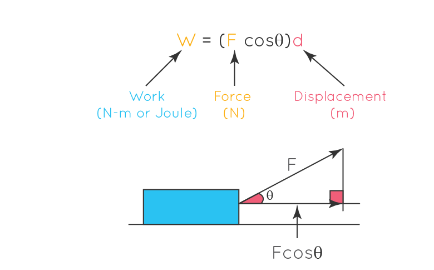
Work Depends On Frame of Reference:In physics, work is a fundamental concept that plays a crucial role in understanding the relationship between forces and motion. The concept of work, as defined in physics, depends significantly on the frame of reference used to analyze and describe physical phenomena. This exploration delves into how the definition and calculation of work in physics are influenced by different frames of reference, illustrating the importance of context in understanding this fundamental concept.
1. Definition of Work in Physics:
In the realm of physics, work is defined as the product of force and displacement in the direction of the force. Mathematically, work (W) is expressed as:

Where:
- W represents the work done.
- F is the applied force.
- d is the displacement.
- θ is the angle between the force and the displacement vectors.
Also Check - Work Done by a Variable Force
2. Work in Different Frame of Reference:
- Inertial Frame of Reference:
- An inertial frame of reference is a frame in which an object subject to no net external forces remains at rest or moves at a constant velocity.
- In an inertial frame, the definition of work remains straightforward and is consistent with the fundamental formula mentioned above.
Also Check - Work Done in Raising a Box Formula
- Non-Inertial Frame of Reference:
- In non-inertial frames, like those that are accelerating or rotating, the calculation of work becomes more complex.
- Pseudo-forces, such as centrifugal and Coriolis forces, may appear in non-inertial frames, affecting the work-energy relationship.
- Relativistic Frame of Reference:
- In the realm of special relativity, where objects approach the speed of light, the concept of work takes on a new dimension.
- The relativistic energy-momentum relationship implies that work done on an object is related to its change in energy, considering both mass and relativistic effects.
3. Work And Conservation of Energy :
In different Frame of Reference the concept of work is intimately linked with the conservation of energy. According to the work-energy theorem, the net work done on an object equals the change in its kinetic energy. This fundamental principle holds true regardless of the frame of reference, making it a powerful tool for analyzing physical systems.
In physics, the understanding of work is closely tied to the frame of reference used to analyze a given situation. While the basic definition of work remains consistent, the complexities introduced by non-inertial frames and relativistic effects highlight the need for a nuanced approach. The concept of work serves as a cornerstone in physics, enabling scientists and engineers to describe, predict, and manipulate the behavior of objects and systems, all while taking into account the specific frame of reference appropriate for the situation.
Some Examples On Work Depends On Frame Of Reference
To better understand how the concept of work in physics depends on the frame of reference, let's explore some practical examples:
- Elevator Ride (Non-Inertial Frame):
Imagine you are in an elevator accelerating upward. From your perspective inside the elevator, you feel a sensation of being "pressed" into the floor. In this non-inertial frame of reference (the accelerating elevator), you might think that work is being done on you. However, if you consider an external, inertial frame of reference, you'll realize that no net work is being done on you because you're not moving relative to the elevator. The sensation of force you feel is due to the elevator's acceleration, not work being done on you.
- Rotating Platform (Non-Inertial Frame):
Suppose you are on a spinning amusement park ride. As you move outward from the center, you feel a force pushing you outward. In this non-inertial frame, you might again think work is being done on you. However, from an external, inertial frame, it's clear that no work is being done since your speed and kinetic energy remain constant. The force you feel is a result of the circular motion and is not associated with work.
- Relativistic Speed (Special Relativity):
Imagine a spaceship traveling close to the speed of light. According to special relativity, as the spaceship approaches the speed of light, its relativistic mass increases, and its kinetic energy increases significantly. From the perspective of an observer on Earth, it may seem like an enormous amount of work is done to accelerate the spaceship. However, the spaceship's occupants, within their own frame of reference, experience no change in their environment, including their sense of work being done.
- Lifting a Box (Inertial Frame):
In an inertial frame of reference, lifting a box vertically requires work to be done against gravity. If you lift a 10 kg box by 2 meters, you do work equal to the force of gravity (weight) times the vertical displacement:
W = F * d = m * g *
Here, m is the mass of the box, g is the acceleration due to gravity, and d is the vertical displacement. In this inertial frame, work is straightforwardly calculated.
In these examples, the perception of work changes depending on the frame of reference. The concept of work remains consistent in an inertial frame, where work is done when a force causes an object to move. However, in non-inertial frames or in situations involving relativistic speeds, the perception of work can differ, demonstrating the importance of considering the frame of reference when analyzing physical phenomena.
Work Depends On Frame of Reference Formula FAQs
What is work in physics, and how is it calculated in an inertial frame of reference?
How does the concept of work change in non-inertial frames of reference?
What happens to the concept of work in situations involving relativistic speeds?
Can work be negative, and what does it signify?










